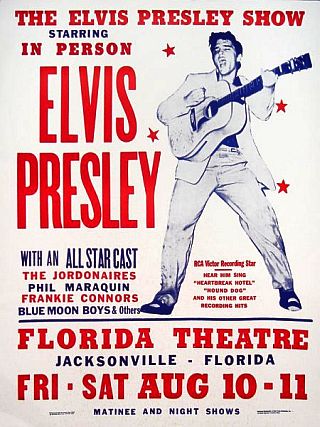
Poster advertising Elvis Presley shows at the Florida Theater in Jacksonville, FL, August 10 &11th, 1956. Click for wall print.
Elvis and band were scheduled to play six shows there over a two-day period, on Friday, August 10th, and Saturday, August 11th, 1956.
America was then beginning its post-WWII baby boom. In June 1956, President Dwight D. Eisenhower signed the Federal Aid Highway Act, creating the Interstate Highway System; Hollywood actress, Marilyn Monroe, had just married playwright Arthur Miller; and heavyweight boxing champion Rocky Marciano retired from his amazing professional boxing career having never lost a match.
Elvis Presley by this time was becoming something of a national pop music sensation. In the previous year, Presley and his band had toured much of the country, especially in the south, getting rave reviews.
On January 28th, 1956, Elvis made his first national television appearance on Stage Show, a CBS TV series then hosted by big band leaders Tommy and Jimmy Dorsey.
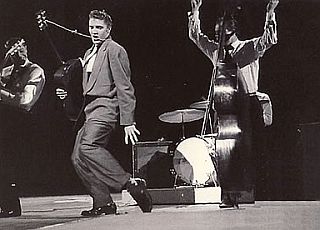
Elvis Presley and a portion of his band performing on TV for the Dorsey Brothers Stage Show, March 17, 1956 -- their 5th show.
Meanwhile, by late February 1956 his song “Heartbreak Hotel” had entered the national music charts for the first time. A month later he released his first album, titled Elvis Presley.
By June 5th, 1956, Presley introduced his new song, “Hound Dog” during a national TV appearance on The Milton Berle Show, “scandalizing the audience with his suggestive hip movements,” according to one report.
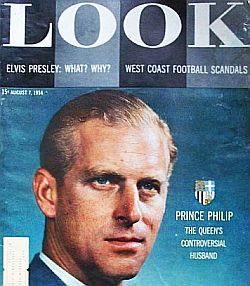
August 1956: Look magazine cover includes upper left-hand corner tagline, “Elvis Presley: What? Why?,” with full story inside. Click for copy.
Inside the magazine, a series of photographs showed Elvis performing during a Dayton, Ohio concert, some capturing his on-stage gestures and movements as he performed, others of screaming and smiling female fans. There were also some shots of Presley at leisure, shooting a game of pool and visiting with friends. But the narrative accompanying the photo spread was not very charitable toward Presley, calling him, “a wild troubadour who wails rock ’n roll tunes, flails erratically at a guitar and wriggles like a peep-show dancer…” Look did admit, however, that Presley had become “a U. S. entertainment sensation.” Here’s more of the Elvis description Look included in its story:
…He is 21-year-old Elvis Presley, a former Memphis, Tenn., truck driver whose sullen sweetness, ducktail haircut and long sideburns send girls (and women) into hysterics. His RCA-Victor records (Heartbreak Hotel, Blue Suede Shoes, etc.) have grossed almost $6 million. Presley’s fans adore him; some trample each other in the effort to tear off his ‘cool’ zoot suits. They send him 3,000 letters a week. His unprecedented success seems incredible to a public devoted to languid crooners. They say, ‘He can’t be!’ But he is, and he has landed on top…
“…But Presley is mostly nightmare. On stage, his gyrations…are vulgar… He has also dragged ‘big beat’ music to new lows in taste…”
– Look magazine, 1956
Elvis Presley’s fame is a legend of the ‘American Dream’ of success that is overshadowed by a nightmare of bad taste.
Here are some of the ‘Dream’ elements: Elvis never took a lesson on his guitar, cannot read music. He paid $4 to make his first record and a twister of reaction began; he was a smash hit on the hillbilly circuit by 1955, without strong promotion. It seems certain that his 1956 income will top $500,000. He does not smoke or drink and night clubs bore him. He is devoted to his parents and bought them a $40,000 air-conditioned home (with swimming pool) in Memphis. He is unusually polite and softspoken. He does everything on impulse, much like the mixed-up teenagers in his favorite movie, Rebel Without a Cause. (Elvis’ film idol is the late James Dean.)
But Presley is mostly nightmare. On-stage, his gyrations, his nose wiping, his leers are vulgar. When asked about the sex element in his act, he answers without blinking his big brown eyes: “Ah don’t see anything wrong with it. Ah just act the way ah feel.” But Elvis will also grin and say, “Without mah left leg, ah’d be dead.” Old friends, like the Memphis Press-Scimitar’s Bob Johnson, advise him to clean up his ‘dances.’ Elvis listens and then goes out and does the same, very old things. His naive intransigence threatens his future.
Presley has taken the rock ‘n’ roll craze to new sales heights. He has also dragged “big beat” music to new lows in taste…
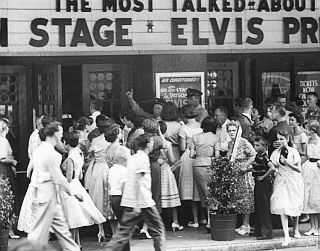 Aug 1956: Elvis Presley fans in Jacksonville, Fl wait for ticket box office to open. Photo, R. Kelley, Life magazine. |
 Aug 1956: Members of the Jacksonville, FL Optimist Club meeting with Judge Gooding (reading Elvis material), to discuss curbing Presley's concert. Life photo. |
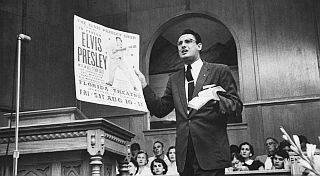 Baptist preacher Robert Gray, holding Elvis poster, denounces singer in Jacksonville, FL. Photo, R. Kelley/Life. |
Back in Florida, meanwhile, Elvis Presley had received some flattering press in the St Petersburg Times. In Jacksonville, posters advertising his forthcoming shows (sample shown at top of this article) had been plastered all around town.
The posters featured Presley in action performing with guitar, billing him as an “RCA Victor Recording Star.” They invited readers to “hear him sing ‘Heartbreak Hotel,’ ‘Hound Dog,’ and his other great recording hits.”
Presley had performed previously in Jacksonville in 1955 with some notable results – both for his music and for the local keepers of moral turpitude.
Mob Scene
It seems that on that visit there had been a little bit of a mob scene when mostly female fans rushed Presley backstage after his performance, tearing at his clothes and creating quite a disturbance. So the town fathers and some local clergy weren’t too happy about Presley coming back to their town again in 1956. But the kids of Jacksonville had eagerly come to the theater to get their tickets.
When Presley and his band finally arrived in Jacksonville for their August performance dates, they were faced with the possibility of arrest. Arrest warrants had been drawn up and stood as a threat to Elvis, prepared by Juvenile Court Judge Marion Gooding.
Charges of “impairing the morals of minors” were included in the warrants and the judge told Elvis and crew that he was quite upset over what had happened on their previous visit and he wanted to prevent a recurrence of those events.
So if Elvis did any of his hip-gyrations during his performance, the Judge said, he would issue those warrants and send Elvis straight to the slammer. He and Elvis had a sit down at one point and came to some agreement.

Aug 1956: Elvis Presley meeting with Judge Gooding in Jacksonville, FL, discussing gyration limitations.
At another service, Rev. Robert Gray, holding a prayer meeting at Trinity Baptist Church told teenagers in attendance that Presley had achieved “a new low in spiritual degeneracy” and might not be offered salvation.
At that service, Rev. Gray asked the teens to pray for Elvis’ redemption. Later, when Elvis learned of this, he was quite offended, noting that had been a church-going person all of his life — “since I could walk.” Elvis would later say, “I feel the preacher was just looking for publicity.”
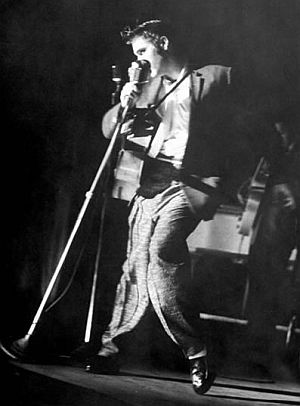
Elvis Presley performing on stage at the Florida Theater in Jacksonville, Florida, August 10th, 1956.
But Elvis did have a little fun with the judge during his performances by wiggling his little finger. “That’s where the curled lip and the little finger thing really got started,” later explained Elvis’ band member Scotty Moore. But mostly, Elvis was a good boy during the shows. “He stood there flat footed and did the whole show,” Moore said of Elvis’ performances. Judge Gooding was reportedly satisfied with the performances as well. But later, Elvis, who professed to being upset over the whole controversy, explained to reporters that he didn’t do “dirty body movements.”
In late August, after Elvis had performed in Jacksonville, Life magazine also included the controversy in a story it did on Elvis. The cover for that August 27th issue of Life, shown below, featured the Democratic Party’s National Convention that summer, along with a photograph of presidential nominee Adlai Stevenson with Eleanor Roosevelt and other admirers. But also in the upper right-hand corner of that cover was a headline announcing the Elvis story — “The Impact of Elvis Presley.”
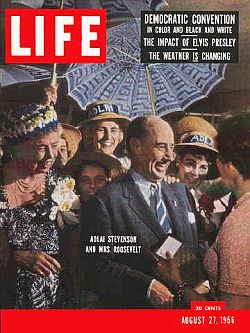
August 1956 cover of Life magazine, featuring Adlai Stevenson and the Democrats, and also, “The Impact of Elvis Presley” story. Click for copy.
On September 9th, 1956, a few weeks after the Jacksonville shows, Elvis appeared on The Ed Sullivan Show for the first time, and from that point on his stardom rocketed to even greater national and international notice.
See also at this website, “Elvis on The Road, 1955-1956,” and “Drew Pearson on Elvis, 1956,” a video with a brief background summary. Additionally, another story, “They Go To Graceland”, is about Presley’s former home and now historic site in Memphis, Tennessee. This story uses a July 2006 visit to Graceland by former U.S. President George Bush and visiting Japanese Prime Minister Junichiro Koizumi as a segue into the history of Graceland, why it has become such a fan-based and tourist mecca, and how some big business interests have taken hold there. For other stories on music-related topics, visit the “Annals of Music” page or the Home Page for additional story choices. Thanks for visiting — and if you like what you find here, please make a donation to help support the research and writing at this website. Thank you. – Jack Doyle
|
Please Support Thank You |
____________________________________
Date Posted: 29 February 2012
Last Update: 5 September 2022
Comments to: jackdoyle47@gmail.com
Twitter: https://twitter.com/PopHistoryDig
Article Citation:
Jack Doyle, “Elvis Riles Florida, 1955-56,”
PopHistoryDig.com, February 29, 2012.
____________________________________
Sources, Links & Additional Information

Aug 1956: Elvis Presley backstage, Jacksonville, Florida.
Anne Rowe, “Broom-Sweeping Elvis A Regular Guy,” St. Petersburg Times, Monday August 6, 1956.
Gereon Zimmerman, “Elvis Presley: What? Why?”Look, August 7, 1956.
Edwin Miller, “Elvis Presley: Rising Star or Passing Fad?,Some Say He’s a Passing Fad, but Hollywood Thinks He’s Another Marlon Brando,”Seventeen, October 1956.
“Fort Homer W. Hesterly Armory,” Scotty Moore.net (includes photos & information on Elvis Presley & band performances).
“CBS TV Studio 50,” ScottyMoore.net (includes photos and information on Elvis Presley & band performances).
“Elvis Presley: What? Why?,” ScottyMoore.net (Look magazine article and photos).
“Radio & TV: Sunday at 8 (re: Steve Allen Show with Presley beats Ed Sullivan Show),” Time, Monday, July 16, 1956.
“Elvis Presley: Jacksonville, FL, Florida Theater, August 10-11, 1956,” ElvisPresleyMusic.com.
Joseph A. Tunzi, Photographs & Memories, JAT Productions, 1998.
“Elvis Aaron Presley 1956: The King of Rock ‘n’ Roll,” ElvisPresleyMusic.com.
“Elvis – A Different Kind of Idol; Presley’s Impact Piles Up Fans, Fads and Fears,” Life (Adlai Stevenson on cover), August 27, 1956, p. 101-109.
_____________________________________________________________________